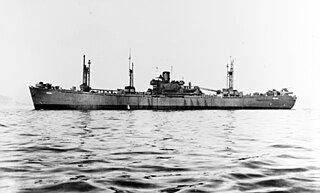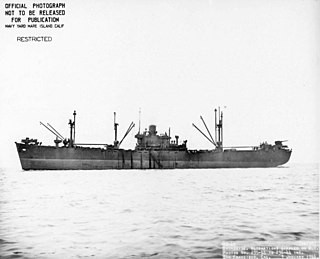Service history
The ship was acquired by the Navy 6 October 1943; renamed Leonis 11 October, and commissioned 25 October 1943.
After shakedown along the west coast, Leonis departed San Pedro 6 December, with cargo for the Pacific islands. Arriving Pago Pago, American Samoa, on 22 December, she remained there until 1 January 1944, when she sailed for Funafuti Atoll, Ellice Islands. From January to April, Leonis shuttled cargo among the Marshall, Gilbert, and Ellice Islands before sailing for Pearl Harbor 19 April.
Assigned to the V Amphibious Corps, Leonis loaded troops at Pearl Harbor and departed the Hawaiian Islands 29 May. According to her status card, with MARAD, her "t'ween" deck, above the No. 3 hold, had extra living quarters, the starboard side had extra heads, washrooms, and laundry, and that amidship on her main deck she had extra hospital and mess rooms. The destination was the Marianas needed "to secure control of sea communications through the central Pacific for the support of further attacks on the Japanese." Leonis arrived in the transport area off Saipan with reinforcements and cargo 20 June, 5 days after the initial landings. Remaining off Saipan until 3 July, she made a brief stop at Eniwetok, then returned to Pearl Harbor on 27 July.
Following training and repairs, the cargo ship departed Pearl Harbor 20 August, to join the forces preparing for the Palau Islands campaign. After stopovers at Kwajalein and Manus, Leonis arrived Kossal Passage 20 September, with men and equipment needed to capture the islands. The Palaus were utilized as an advance base for the Leyte operations, and Leonis remained off Peleliu until mid-November.
After loading Marines and other passengers at Peleliu, the Russell Islands, Tulagi, and Guadalcanal, the cargo ship sailed for the United States, arriving San Francisco 18 December. Reloading with battle supplies, Leonis departed San Francisco 11 January 1945 to join the Western Pacific Forces as a fleet issue ship.
Touching the Marshalls and Carolinas en route, she arrived San Pedro Bay, Leyte Gulf, 28 February. For the rest of the war she remained primarily in the Philippines supplying the fleet with dry stores and medical provisions. Following the Japanese surrender, Leonis departed Leyte 4 September, arriving San Pedro, California, 1 month later.
Inactivation and decommissioning
Sailing again 15 October, the veteran cargo ship proceeded toward the East Coast, arriving Norfolk, Virginia 6 November. Leonis decommissioned there 5 December 1945 and was returned to WSA the 9 December. Her name also reverted to Key Pittman.
The ship was subsequently laid up in the National Defense Reserve Fleet, James River Group, Lee Hall, Virginia. Key Pittman was sold on 29 April 1966, to Universal Salvage Corporation, but she was returned in August because of default in payment. She was again sold on 2 November 1967, for scrapping, to North American Smelting Company. She was delivered 21 November 1967, with scrapping completed 17 November 1968.

USS Arided (AK-73), a Crater-class cargo ship, is the only ship of the US Navy to have this name. She was named after Arided, the other name of Deneb, the alpha star of constellation Cygnus.

USS Naos (AK-105) was a Crater-class cargo ship commissioned by the US Navy for service in World War II. Naos was named after the star Naos, in the constellation Puppis. She was responsible for delivering troops, goods and equipment to locations in the Asiatic-Pacific Theater.

USS Giansar (AK-111) was a Crater-class cargo ship originally laid down as the liberty ship SS Thomas Ewing. The ship was taken over by the United States Navy and renamed in 1943. After being decommissioned in 1945, Giansar was returned to the Maritime Commission. She was scrapped in 1963. The ship's original name honored Thomas Ewing, an American politician from Virginia. The name Giansar is a former name of the star λ Draconis in the constellation Draco now spelled Giausar.

USS Cheleb (AK-138) was a Crater-class cargo ship in the service of the US Navy in World War II. It was the only ship of the Navy to have borne this name. It is named after Cheleb, a star in the northern hemisphere constellation of Ophiuchus.

The USS Albireo (AK-90) was a Crater-class cargo ship in the service of the US Navy in World War II and manned by a US Coast Guard crew. She was the only ship of the Navy to have borne this name. She is named after Albireo, a star in the constellation of Cygnus.

USS Crater (AK-70) was the lead ship of her class of converted liberty ship cargo ships in the service of the US Navy in World War II. She was first named after John James Audubon, an American ornithologist, naturalist, and painter. She was renamed and commissioned after the constellation Crater, she was the only ship of the Navy to bear this name.
USS Prince Georges (AP-165/AK-224) was a Crater-class cargo ship in the service of the US Navy in World War II. Named after the Prince George's County, Maryland, it was the only ship of the Navy to bear this name.

The USS Alnitah (AK-127) was a Crater-class cargo ship in the service of the US Navy in World War II. Named a spelling variation of the star Alnitak in the constellation Orion, it was the only ship of the Navy to bear this name.

USS Zebra (AKN-5) was an Indus-class net cargo ship in the service of the United States Navy in World War II. The ship was originally the Matthew Lyon, an EC2-S-C1 Liberty ship, operated for the War Shipping Administration (WSA) as a cargo vessel by an agent until severely damaged by torpedo in August 1943. While at Espiritu Santo in the New Hebrides awaiting likely scrapping the Navy acquired the vessel under bareboat charter to be used as a net cargo ship transporting reclaimed anti-submarine netting.

USS Triangulum (AK-102) was a Crater-class cargo ship commissioned by the US Navy for service in World War II. Triangulum was named after the constellation Triangulum. She was responsible for delivering troops, goods and equipment to locations in the Asiatic-Pacific Theater.

USS Ganymede (AK-104) was a Crater-class cargo ship commissioned by the US Navy for service in World War II. She was responsible for delivering troops, goods and equipment to locations in the war zone. Named after the largest of the moons of Jupiter, Ganymede was the only ship of the Navy to bear this name.

USS Allioth (AK-109/IX-204/AVS-4) was a Crater-class cargo ship commissioned by the US Navy for service in World War II, named after Alioth, a star in constellation Ursa Major. She was responsible for delivering troops, goods and equipment to locations in the war zone.

USS Sabik (AK-121) was a Crater-class cargo ship commissioned by the U.S. Navy for service in World War II. She was responsible for delivering troops, goods and equipment to locations in the war zone.

USS Lesuth (AK-125) was a Crater-class cargo ship commissioned by the US Navy for service in World War II. Lesuth was named after the star Lesuth in the constellation Scorpius. She was responsible for delivering troops, goods and equipment to locations in the Asiatic-Pacific Theater.

USS Megrez (AK-126) was a Crater-class cargo ship commissioned by the US Navy for service in World War II. Megrez was named after Megrez, a star in the constellation Ursa Major. She was responsible for delivering troops, goods and equipment to locations in the Asiatic-Pacific Theater.

USS Ara (AK-136) was a Crater-class cargo ship commissioned by the US Navy for service in World War II. Ara is named after the constellation Ara. She was responsible for delivering troops, goods and equipment to locations in the Asiatic-Pacific Theater.
USS Pavo (AK-139) was a Crater-class cargo ship commissioned by the U.S. Navy for service in World War II, named after the constellation Pavo. She was responsible for delivering troops, goods and equipment to locations in the war zone.

USS Mayfield Victory (AK-232) was a Boulder Victory-class cargo ship acquired by the U.S. Navy during World War II. She served in the Pacific Ocean theatre of operations through the end of the war and then returned to the United States for disposal.
USS Newcastle Victory (AK-233) was a Boulder Victory-class cargo ship acquired by the U.S. Navy during World War II. She served in the Pacific Ocean theatre of operations through the end of the war, and then returned to the United States of America for disposal.

USS Lakewood Victory (AK-236) was a Boulder Victory-class cargo ship acquired by the U.S. Navy during World War II. She served in the Pacific Ocean theatre of operations through the end of the war, earning two battle stars, and then returned to the United States for disposal.
















